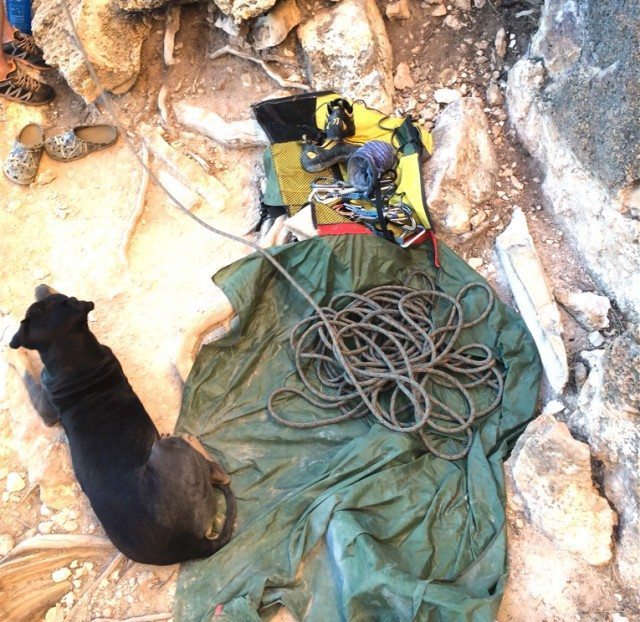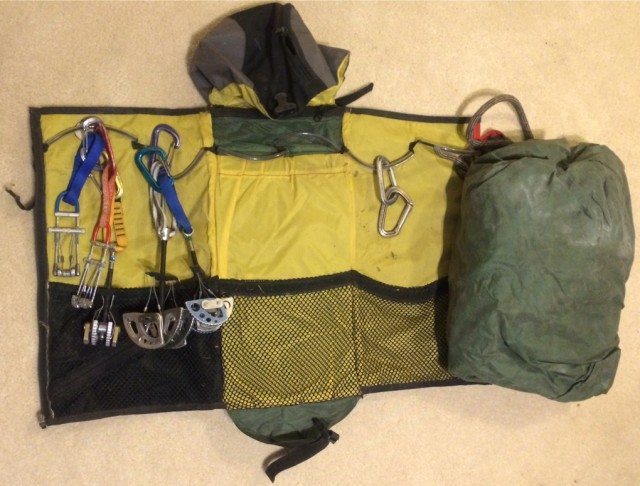
Boulder5 Cragging Pack
MSRP: $145
Days Tested: 30
Test Locations: Clear Creek Canyon, Eldorado Canyon, Shelf Road, CO; Indian Creek, UT; Index, WA
After working in the soft goods industry for GoLite and Pearl Izumi, George Shumate decided to start making packs by hand—he simply wasn’t impressed with the rope bags on the market, and he thought he could improve on the design. So he founded his own company, Boulder5, this year.
The rope bag I tested was the result of several iterations of tinkering. It’s a backpack-style bag with a large carrying capacity, a built-in tarp, and a full length zipper that lets you unroll the pack so that its walls lie flat on the ground.
Size
The pack’s relatively large capacity—roughly 35 liters—places it between often frustratingly small rope bags and full-size backpacking packs.
For some sense of scale, I can fit a 70m 9.8 cragging rope, at least a dozen draws, a pair of shoes, and my harness inside the Boulder5 pack. The top of the pack is designed for a helmet, and I’ve taken to carrying my chalk bag in the top of the pack as well, nested inside the helmet. If I hang my shoes on the outside, I’ve been able to squeeze a small trad rack in the pack as well. This is nice for single pitch trad climbs or routes where I don’t need a lot of gear to protect multiple pitches.
This sizing makes the pack feel more like a hybrid crag bag—a cross between something like the Arc’teryx Miura and a rope bag such as the Metolius Porta-Cord or Black Diamond Superslacker.
I tend to prefer these crag bags over smaller rope bags. While having a slim pack exclusively for a rope sounds nice, inevitably I need a second bag to carry my harness, shoes, draws, etc. And I hate the awkwardness that comes from using both a day pack and an over-the-shoulder style rope bag.
The Boulder5 pack isn’t quite large enough to comfortably bring a double rack or your off-width gear wish list, but I don’t see this as much of a drawback. The reality is I’m rarely dragging truly large amounts of gear to the crag, and on the occasions when I am weighed down, I’m going to reach for a large top-loading pack with a hip belt.
It’s this conceptual compromise that defines the Boulder5 cragging pack: while it’s bigger and more versatile than a rope bag, it’s smaller and has less carrying capacity than a true backpack or alpine climbing pack.
Comfort
Since it’s a bit larger than most rope bags, this pack accommodates a larger, heavier amount of gear. (I probably fit close to 35 lbs. in it on more than one occasion.) Without an internal frame, I was concerned about how comfortably it would carry when fully weighed down, but I found the foam that lines the back is enough to make carrying the pack pretty comfortable.
The pack weighs less since it doesn’t have a frame, a plus for those steep approaches. Granted, without the support of an internal frame I wouldn’t want to do any serious hiking with the Boulder5, but as a crag bag, it isn’t meant to replace your hiking pack anyway. The longest approach I did with this pack was about an hour.
The pack does have a sleeve behind the back panel that can accommodate a hydration bladder should you do find yourself facing a particularly aggressive approach.
“Burrito” Design
The Boulder5 pack has a full-length zipper so you can unroll the pack and lie its walls flat on the ground. When you include the 25-square foot tarp (or 60”x60”), the total ground area covered by the unrolled pack is about 35-square feet.
Unlike the Arc’teryx Miura, which uses a clamshell-style closure to let the pack open up completely, the Boulder5 unzips right down the middle so you can roll it and unroll it like a burrito.

This “burrito” design makes it easy to access and organize gear since everything is laid out before you—the rope sits on the tarp, while the inside pockets and gear loops hold your draws, cams, and other gear. I found this system to be vastly more convenient than digging through a top-loading pack when I’m trying to find gear buried at the bottom.
This pack also makes packing up all your gear really easy—all you have to do is toss the rope onto the tarp, roll the pack up, and zip it closed. Since the tarp is so big (60”x60”), I can completely wrap my 70m rope in it before closing the pack, and thus prevent the draws etc. in the pack from getting tangled with the rope.
Finally, the tarp is connected to the pack by a zipper, which lets you detach it from the pack. Unlike the exterior of the pack, the tarp is made from light, thin material. I initially wondered if this would make the tarp less durable (after all, it is meant to be repeatedly tossed on the ground), but so far, it’s proven itself to be very strong.
NEXT PAGE: Drawbacks?

